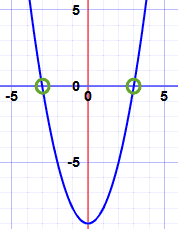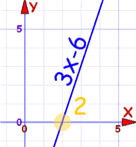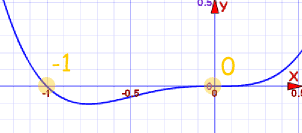The Fundamental Theorem Of Algebra
Fundamental Theorem of Algebra
The "Central Theorem of Algebra" is non the starting time of algebra or annihilation, but it does say something interesting most polynomials:
Any polynomial of degree n has north roots
but nosotros may demand to use complex numbers
Let me explain:
A Polynomial looks like this:
 |
| case of a polynomial this one has three terms |
A "root" (or "zero") is where the polynomial is equal to zippo.

And so, a polynomial of degree three will have 3 roots (places where the polynomial is equal to nada). A polynomial of degree 4 will have 4 roots. And and then on.
Example: what are the roots of x2 − nine?
xii − ix has a degree of two (the largest exponent of x is 2), so at that place are 2 roots.
Allow us solve it. We want it to be equal to zero:
xtwo − 9 = 0
Add 9 to both sides:
102 = +9
Then take the square root of both sides:
10 = ±3
So the roots are −three and +iii

And in that location is something else of interest:
A polynomial tin be rewritten like this:

The factors like (x−ri) are called Linear Factors, because they make a line when nosotros plot them.
Example: x2 − 9
The roots are r1 = −3 and rii = +iii (equally we discovered above) and then the factors are:
x2 − 9 = (ten+iii)(ten−3)
(in this case a is equal to one so I didn't put it in)
The Linear Factors are (x+3) and (10−3)
And so knowing the roots means we also know the factors.
Here is some other instance:
Example: 3x2 − 12
Information technology is degree 2, so there are 2 roots.
Let united states find the roots: We desire information technology to be equal to cypher:
3xii − 12 = 0
3 and 12 have a common gene of three:
3(x2 − 4) = 0
We tin solve 102 − 4 by moving the −4 to the correct and taking square roots:
tenii = 4
x = ±2
So the roots are:
ten = −2 and x = +two
And and so the factors are:
3x2 − 12 = 3(x+2)(x−2)
Too, when we know the factors of a polynomial we also know the roots.
Example: 3x2 − 18x + 24
It is caste 2 so there are ii factors.
3xii − 18x + 24 = a(10−rane)(x−r2)
I simply happen to know this is the factoring:
3x2 − 18x + 24 = iii(x−two)(10−4)
And so the roots (zeros) are:
- +two
- +4
Let us check those roots:
3(ii)2 − 18(two) + 24 = 12 − 36 + 24 = 0
3(4)2 − 18(4) + 24 = 48 − 72 + 24 = 0
Yeah! The polynomial is zero at x = +2 and x = +4
Complex Numbers
We may need to use Complex Numbers to make the polynomial equal to null.

And hither is an instance:
Example: x2−x+1
Can we arrive equal to zero?
102−x+1 = 0
Using the Quadratic Equation Solver the answer (to 3 decimal places) is:
| 0.v − 0.866i | and | 0.5 + 0.866i |
They are circuitous numbers! But they nevertheless piece of work.
And and then the factors are:
10two−x+ane = ( x − (0.v−0.866i ) )( ten − (0.five+0.866i ) )
Circuitous Pairs
So the roots r1, r2, ... etc may be Real or Circuitous Numbers.
But there is something interesting...
Complex Roots always come in pairs!

Y'all saw that in our example in a higher place:
Example: tentwo−10+i
Has these roots:
| 0.5 − 0.866i | and | 0.5 + 0.866i |
The pair are actually circuitous conjugates (where nosotros change the sign in the middle) similar this:

Always in pairs? Yep (unless the polynomial has complex coefficients, only we are only looking at polynomials with real coefficients hither!)
So nosotros either become:
- no complex roots
- 2 complex roots
- 4 complex roots,
- etc
And never 1, iii, 5, etc.
Which means we automatically know this:
| Degree | Roots | Possible Combinations |
|---|---|---|
| 1 | i | ane Real Root |
| 2 | ii | 2 Real Roots, or 2 Complex Roots |
| three | 3 | 3 Existent Roots, or ane Existent and 2 Complex Roots |
| four | iv | 4 Real Roots, or two Real and two Complex Roots, or four Complex Roots |
| etc | etc! |
And so:
When the caste is odd (one, 3, 5, etc) there is at least one real root ... guaranteed!
Case: 3x−six
The degree is ane.
There is one existent root
At +ii actually:
 :
:
You tin can actually run across that information technology must get through the ten-axis at some point.
But Real is also Circuitous!
I have been saying "Real" and "Complex", only Complex Numbers do include the Real Numbers.
Then when I say there are "two Real, and 2 Complex Roots", I should exist saying something like "2 Purely Real (no Imaginary part), and 2 Circuitous (with a non-null Imaginary Part) Roots" ...
... simply that is a lot of words that sound confusing ...
... and so I hope you don't listen my (maybe also) unproblematic language.
Don't Want Complex Numbers?
If nosotros don't desire Complex Numbers, we can multiply pairs of complex roots together:
(a + bi)(a − bi) = a2 + b2
We become a Quadratic Equation with no Circuitous Numbers ... it is purely Real.
That blazon of Quadratic (where we can't "reduce" it any further without using Complex Numbers) is called an Irreducible Quadratic.
And remember that simple factors like (10-ri) are chosen Linear Factors
Then a polynomial can exist factored into all Existent values using:
- Linear Factors, and
- Irreducible Quadratics
Example: xiii−i
x3−1 = (x−1)(x2+x+1)
It has been factored into:
- 1 linear factor: (x−ane)
- 1 irreducible quadratic factor: (xtwo+x+i)
To factor (x2+x+1) farther we demand to use Complex Numbers, and then it is an "Irreducible Quadratic"
How do we know if the Quadratic is Irreducible?
Just calculate the "discriminant": b2 - 4ac
(Read Quadratic Equations to learn more well-nigh the discriminant.)
When b2 − 4ac is negative, the Quadratic has Complex solutions,
and then is "Irreducible"
Instance: 2xtwo+3x+5
a = ii, b = iii, and c = five:
b2 − 4ac = three2 − 4×2×5 = ix−forty = −31
The discriminant is negative, and so information technology is an "Irreducible Quadratic"
Multiplicity
Sometimes a cistron appears more than once. That is its Multiplicity.
Example: xtwo−6x+nine
x2−6x+9 = (x−three)(x−iii)
"(10−3)" appears twice, so the root "three" has Multiplicity of 2
The Multiplicities are included when we say "a polynomial of degree due north has due north roots".
Example: xiv+x3
There should exist 4 roots (and 4 factors), correct?
Factoring is easy, just factor out 10iii :
ten4+x3 = 10three(ten+1) = x·x·10·(10+ane)
there are 4 factors, with "x" appearing three times.
But there seem to be but 2 roots, at x=−1 and x=0:

But counting Multiplicities there are really iv:
- "10" appears 3 times, then the root "0" has a Multiplicity of 3
- "ten+1" appears one time, so the root "−1" has a Multiplicity of ane
Total = 3+1 = 4
Summary
- A polynomial of degree n has due north roots (where the polynomial is zero)
- A polynomial can exist factored like: a(10−r1)(x−r2) ... where r1, etc are the roots
- Roots may need to be Circuitous Numbers
- Complex Roots always come up in pairs
- Multiplying a Complex pair gives an Irreducible Quadratic
- And so a polynomial can exist factored into all real factors which are either:
- Linear Factors or
- Irreducible Quadratics
- Sometimes a gene appears more than in one case. That is its Multiplicity.
The Fundamental Theorem Of Algebra,
Source: https://www.mathsisfun.com/algebra/fundamental-theorem-algebra.html
Posted by: motenbobyth.blogspot.com


0 Response to "The Fundamental Theorem Of Algebra"
Post a Comment